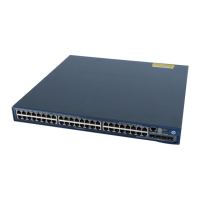110
[DeviceA-vlan200] port gigabitethernet 1/0/2
[DeviceA-vlan200] quit
# Configure port GigabitEthernet 1/0/3 as a trunk port, and assign it to VLANs 100 and 200, to enable
GigabitEthernet 1/0/3 to forward traffic of VLANs 100 and 200 to Device B.
[DeviceA] interface gigabitethernet 1/0/3
[DeviceA-GigabitEthernet1/0/3] port link-type trunk
[DeviceA-GigabitEthernet1/0/3] port trunk permit vlan 100 200
Please wait... Done.
2. Configure Device B as you configure Device A.
3. Configure Host A and Host C to be on the same network segment, 192.168.100.0/24, for
example. Configure Host B and Host D to be on the same network segment, 192.168.200.0/24,
for example.
Verification
1. Host A and Host C and ping each other successfully, but they both fail to ping Host B. Host B and
Host D and ping each other successfully, but they both fail to ping Host A.
2. Determine whether the configuration is successful by displaying relevant VLAN information.
# Display information about VLANs 100 and 200 on Device A:
[DeviceA-GigabitEthernet1/0/3] display vlan 100
VLAN ID: 100
VLAN Type: static
Route Interface: not configured
Description: protocol VLAN for IPv4
Name: VLAN 0100
Tagged Ports:
GigabitEthernet1/0/3
Untagged Ports:
GigabitEthernet1/0/1
[DeviceA-GigabitEthernet1/0/3] display vlan 200
VLAN ID: 200
VLAN Type: static
Route Interface: not configured
Description: protocol VLAN for IPv6
Name: VLAN 0200
Tagged Ports:
GigabitEthernet1/0/3
Untagged Ports:
GigabitEthernet1/0/2
MAC-based VLAN configuration
Introduction to MAC-based VLAN
The MAC-based VLAN feature assigns hosts to a VLAN based on their MAC addresses. The following
approaches are available for configuring MAC-based VLANs:

